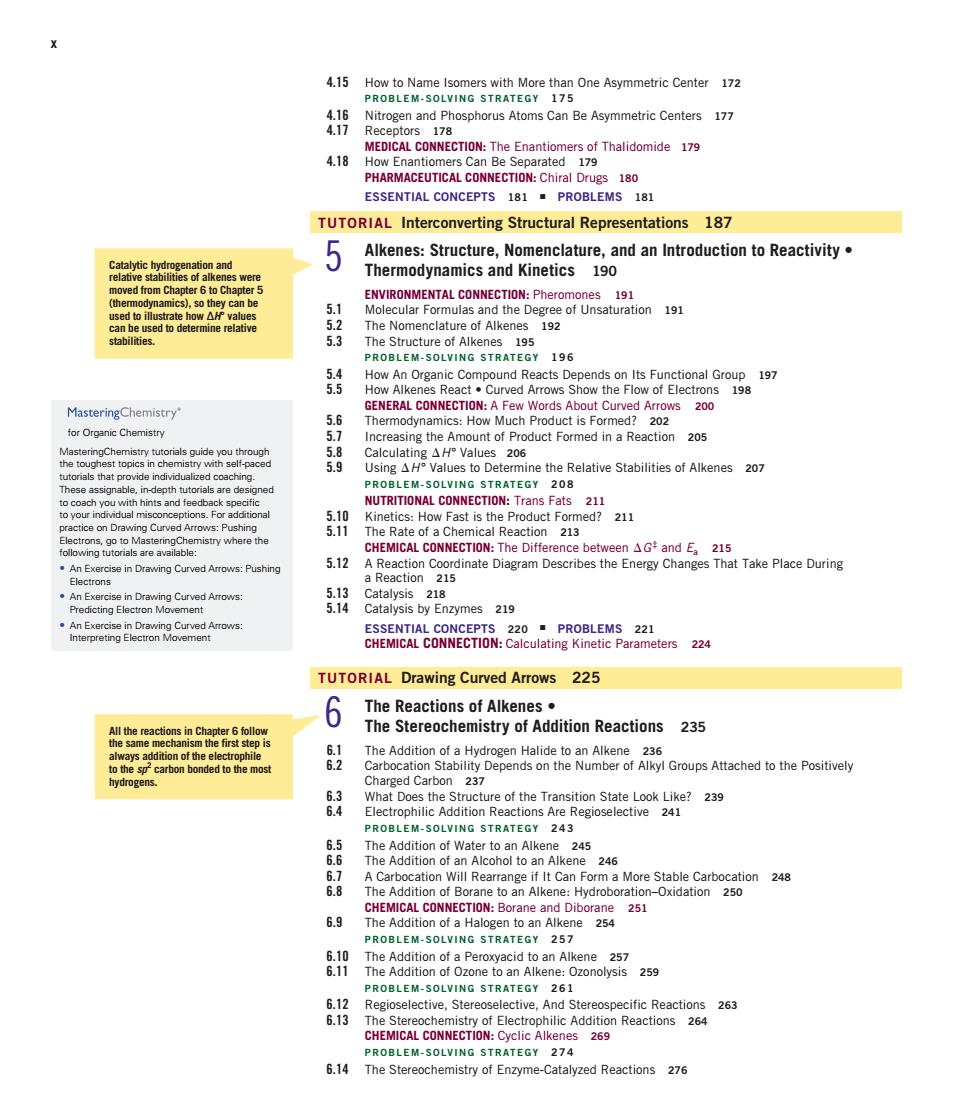正在加载图片...

带 Nitrogen and Phosphorus Atoms Can Be Asymmetric Centers 177 TION:The Enan sof Thalidomide179 PHARM ESSENTIAL CONCEPTS 181 PROBLEMS 181 TUTORIAL Interconverting Structural Representations 187 5 Alkenes Structure Nomenclaturend a troduction to Reactivity Thermodynamics and Kinetics 6 to Ch ENVIRONMENTAL CONNECTION:Pherom The Structure of Alkenes 195 M-SOLVING STRATEGY 196 GENERAL CONNECTION:A Few Words A tCurved Arrows 200 for Organic Chemistry Increasing the Amount of Product Formed ina e the Relative Stabilities of Alkenes 20 PROBLEM-SOLVING STRATEGY 208 NUTRITIONAL CONNECTION:Trans Fats 211 1e0721 on Dr CHEMICAL CONNECTION:The Difference between AG and E 215 An Exercise in Drawing Curved Amows:Pushing 5.12 Reac Diagram Dscribes the Energy Changes That Take Place During An Exer An Exe eters 224 TUTORIAL Drawing Curved Arrows 225 6 The Reactions of Alkenes. The Stereochemistry of Addition Reactions 235 n of e Halide toa 23 of the tran sition State Look Like?239 PROBLEM-SOLVING STRATEGY 243 TheAdgm8mtcoonoke7 246 CHEMICAL CONNECTION:Borane and Diborane 251 6.9 ne254 89 T p ne257 The Addition of Ozone to an Alkene:Ozonolysis 259 6.12 PROBLEM-SOLVING STRATEGY e t 6.13 263 CHEMICAL CONNEC ON Cyclic 6.14 The Enzyme-Cata alyzed Reactions 276 Catalytic hydrogenation and relative stabilities of alkenes were moved from Chapter 6 to Chapter 5 (thermodynamics), so they can be used to illustrate how ΔH° values can be used to determine relative stabilities. x All the reactions in Chapter 6 follow the same mechanism the first step is always addition of the electrophile to the sp2 carbon bonded to the most hydrogens. for Organic Chemistry MasteringChemistry tutorials guide you through the toughest topics in chemistry with self-paced tutorials that provide individualized coaching. These assignable, in-depth tutorials are designed to coach you with hints and feedback specific to your individual misconceptions. For additional practice on Drawing Curved Arrows: Pushing Electrons, go to MasteringChemistry where the following tutorials are available: • An Exercise in Drawing Curved Arrows: Pushing Electrons • An Exercise in Drawing Curved Arrows: Predicting Electron Movement • An Exercise in Drawing Curved Arrows: Interpreting Electron Movement 4.15 How to Name Isomers with More than One Asymmetric Center 172 PROBLEM-SOLVING STRATEGY 175 4.16 Nitrogen and Phosphorus Atoms Can Be Asymmetric Centers 177 4.17 Receptors 178 MEDICAL CONNECTION: The Enantiomers of Thalidomide 179 4.18 How Enantiomers Can Be Separated 179 PHARMACEUTICAL CONNECTION: Chiral Drugs 180 ESSENTIAL CONCEPTS 181 ■ PROBLEMS 181 TUTORIAL Interconverting Structural Representations 187 5 Alkenes: Structure, Nomenclature, and an Introduction to Reactivity • Thermodynamics and Kinetics 190 ENVIRONMENTAL CONNECTION: Pheromones 191 5.1 Molecular Formulas and the Degree of Unsaturation 191 5.2 The Nomenclature of Alkenes 192 5.3 The Structure of Alkenes 195 PROBLEM-SOLVING STRATEGY 196 5.4 How An Organic Compound Reacts Depends on Its Functional Group 197 5.5 How Alkenes React • Curved Arrows Show the Flow of Electrons 198 GENERAL CONNECTION: A Few Words About Curved Arrows 200 5.6 Thermodynamics: How Much Product is Formed? 202 5.7 Increasing the Amount of Product Formed in a Reaction 205 5.8 Calculating ∆H° Values 206 5.9 Using ∆H° Values to Determine the Relative Stabilities of Alkenes 207 PROBLEM-SOLVING STRATEGY 208 NUTRITIONAL CONNECTION: Trans Fats 211 5.10 Kinetics: How Fast is the Product Formed? 211 5.11 The Rate of a Chemical Reaction 213 CHEMICAL CONNECTION: The Difference between ∆G‡ and Ea 215 5.12 A Reaction Coordinate Diagram Describes the Energy Changes That Take Place During a Reaction 215 5.13 Catalysis 218 5.14 Catalysis by Enzymes 219 ESSENTIAL CONCEPTS 220 ■ PROBLEMS 221 CHEMICAL CONNECTION: Calculating Kinetic Parameters 224 TUTORIAL Drawing Curved Arrows 225 6 The Reactions of Alkenes • The Stereochemistry of Addition Reactions 235 6.1 The Addition of a Hydrogen Halide to an Alkene 236 6.2 Carbocation Stability Depends on the Number of Alkyl Groups Attached to the Positively Charged Carbon 237 6.3 What Does the Structure of the Transition State Look Like? 239 6.4 Electrophilic Addition Reactions Are Regioselective 241 PROBLEM-SOLVING STRATEGY 243 6.5 The Addition of Water to an Alkene 245 6.6 The Addition of an Alcohol to an Alkene 246 6.7 A Carbocation Will Rearrange if It Can Form a More Stable Carbocation 248 6.8 The Addition of Borane to an Alkene: Hydroboration–Oxidation 250 CHEMICAL CONNECTION: Borane and Diborane 251 6.9 The Addition of a Halogen to an Alkene 254 PROBLEM-SOLVING STRATEGY 257 6.10 The Addition of a Peroxyacid to an Alkene 257 6.11 The Addition of Ozone to an Alkene: Ozonolysis 259 PROBLEM-SOLVING STRATEGY 261 6.12 Regioselective, Stereoselective, And Stereospecific Reactions 263 6.13 The Stereochemistry of Electrophilic Addition Reactions 264 CHEMICAL CONNECTION: Cyclic Alkenes 269 PROBLEM-SOLVING STRATEGY 274 6.14 The Stereochemistry of Enzyme-Catalyzed Reactions 276